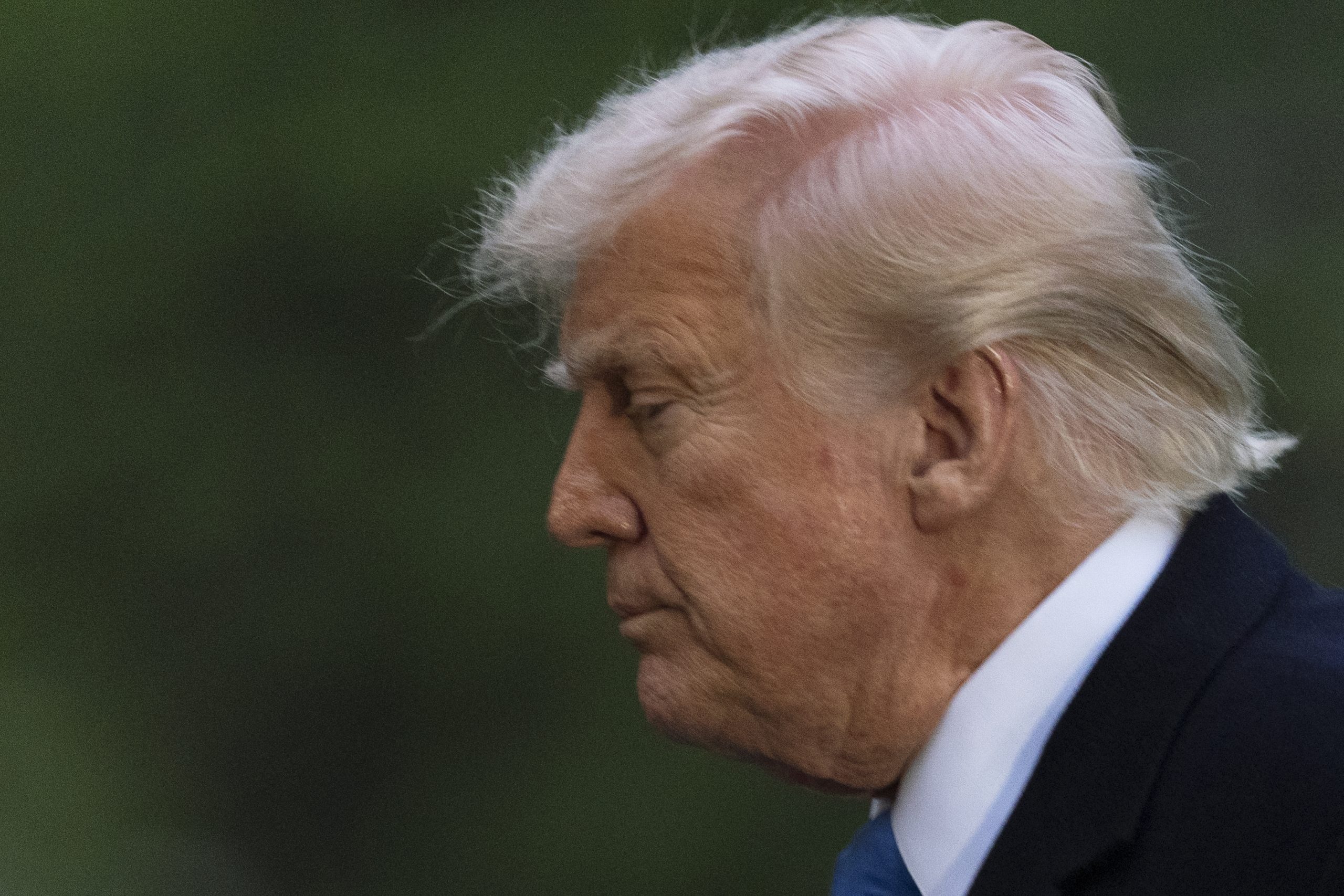US stocks are falling a manic Monday after US President Donald Trump doubled down on his tariffs, despite seeing how much financial markets would love to see him do the opposite.
The losses came after European and Asian shares tumbled sharply and more than $100 billion was wiped off the ASX in Australia on Monday in the worst day of trading in almost five years.
The Dow Jones Industrial Average was down 744 points, or 1.9 per cent, as of noon on Monday in New York (2am Tuesday AEDT), and the Nasdaq composite was 1.1 per cent lower.
READ MORE: ASX haemorrhages $100b in worst trading day in almost five years
Earlier in a heart-racing morning, the Dow fell as many as 1700 points shortly after trading began, following even worse losses worldwide on worries that Trump’s tariffs could torpedo the global economy. But it suddenly surged to a leap of nearly 900 points before pulling back lower.
The S&P 500 at one point went from a loss of 4.7 per cent to a gain of 3.4 per cent, which would have been its biggest jump in years.
The whipsaw swings shook the market as a White House account on X said a rumour circulating that Trump was considering a 90-day pause on his tariffs was “fake news”.
That a rumour could move trillions of dollars’ worth of investments shows how hard investors are straining to see hopes that Trump may let up on his stiff tariffs, which have started a global trade war.
Within less than an hour of that “fake news” announcement, though, Trump threatened to raise tariffs further against China after the world’s second-largest economy retaliated last week with its own set of tariffs on US products.
It’s all a slap in the face to Wall Street, not just because of the sharp losses it’s taking, but because it suggests Trump may not be moved by its pain. Many professional investors had long thought that a president who used to crow about records reached under his watch would pull back on policies if they sent the Dow reeling.
READ MORE: Man found dead in regional Victoria, son under police guard in hospital

On Sunday Trump told reporters aboard Air Force One that he does not want markets to fall. But he also said he wasn’t concerned about a sell-off, saying “sometimes you have to take medicine to fix something”.
Trump has given several reasons for his stiff tariffs, including to bring manufacturing jobs back to the US, which is a process that could take years. Trump on Sunday said he wanted to bring down the numbers for how much more the US imports from other countries versus how much it sends to them.
“The recent tariffs will likely increase inflation and are causing many to consider a greater probability of a recession,” JPMorgan CEO Jamie Dimon, one of the most influential executives on Wall Street, wrote in his annual letter to shareholders on Monday.
“Whether or not the menu of tariffs causes a recession remains in question, but it will slow down growth.”
The financial pain once again hammered investments around the world. Stocks in Hong Kong plunged 13.2 per cent for their worst day since 1997. A barrel of benchmark US crude oil briefly dropped below $US60 ($100) for the first time since 2021, hurt by worries that a global economy weakened by trade barriers will burn less fuel. Bitcoin sank below $US78,000, down from its record above $US100,000 set in January, after holding steadier than other markets last week.
Trump’s tariffs are an attack on the globalisation that’s remade the world’s economy, which helped bring down prices for products on the shelves of US stores but also caused production jobs to leave for other countries.
It also adds pressure on the Federal Reserve. Investors have become nearly conditioned to expect the central bank to swoop in as a hero during downturns.
By slashing interest rates to make borrowing easier for US households and companies, along with other more untraditional moves to juice the economy, the Fed helped the US economy recover from the 2008 financial crisis, the 2020 COVID-19 crash and other bear markets.

But the Fed may have less freedom to act this time around because the conditions are so much different. For one, instead of a coronavirus or a system built up on too much belief that US home prices would keep rising, this market downturn is mostly because of economic policy from the White House.
Perhaps more importantly, inflation is also higher at the moment than the Fed would like. And while lower interest rates can goose the economy, they can also put upward pressure on inflation. Expectations for inflation are already swinging higher because of Trump’s tariffs, which would likely raise prices for anything imported.
“The idea that there’s so much uncertainty going forward about how these tariffs are going to play out, that’s what’s really driving this plummet in the stock prices,” said Rintaro Nishimura, an associate at the Asia Group.
If the S&P 500 finishes the day more than 20 per cent below its record, it’s a big enough drop that Wall Street has a name for it. A “bear market” signifies a downturn that’s moved beyond a run-of-the-mill 10 per cent drop, which happens every year or so, and has graduated into something more vicious.
The index, which sits at the heart of many investors’ 401(k) accounts, has lost nearly 20 per cent since setting a record less than two months ago. It’s coming off its worst week since COVID-19 began crashing the global economy in March 2020.
Nathan Thooft, chief investment officer and senior portfolio manager at Manulife Investment Management, said more countries are likely to respond to the US with retaliatory tariffs. Given the large number of countries involved, “it will take a considerable amount of time in our view to work through the various negotiations that are likely to happen”.
“Ultimately, our take is market uncertainly and volatility are likely to persist for some time,” he said.
The massive sell-off in riskier assets at the start of the trading week follows Trump’s announcement of sharply higher US import taxes and retaliation from China that saw markets fall sharply on Thursday and Friday.

Trump’s tariff strategy has long been criticised by economists, investors and business leaders, who fear that US isolation will severely limit economic growth.
Tokyo’s Nikkei 225 index lost nearly 8 per cent shortly after the market opened and futures trading for the benchmark was briefly suspended. It closed down 7.8 per cent at 31,136.58.
European shares followed Asian markets lower, led by Germany’s DAX index, which briefly fell more than 10 per cent at the open on the Frankfurt exchange, but recovered some ground to move down 4.8 per cent in midday trading. In Paris, the CAC 40 shed 5.1 per cent, while Britain’s FTSE 100 lost 4.9 per cent.
Late on Sunday, Trump reiterated his resolve on his decision to introduce tariffs of 10 per cent to 50 per cent on goods imported into the US, a move seen as massively disrupting world trade and supply chains across borders. Speaking to reporters aboard Air Force One, he said he didn’t want global markets to fall, but also that he wasn’t concerned about the massive sell-offs, adding, “sometimes you have to take medicine to fix something”.

Trump posted on his Truth Social site early on Monday, blaming China and other “abusing countries” for retaliating against the US with additional tariffs.
Heavy selling kicked in after China on Friday matched Trump’s tariff, upping the stakes in a trade war that many fear could end in a global recession. Even a better-than-expected report on the US job market, usually the economic highlight of each month, wasn’t enough to stop the slide.
DOWNLOAD THE 9NEWS APP: Stay across all the latest in breaking news, sport, politics and the weather via our news app and get notifications sent straight to your smartphone. Available on the Apple App Store and Google Play.

